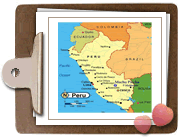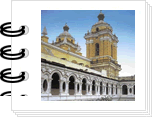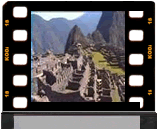Exciting culture in Latin America
-
Peru is in western South America and shares borders with Chile (to the south), Bolivia
 (southeast), Brazil (northeast), Colombia
(north) and Ecuador (northwest). It has three major regions: a
narrow coastal belt, the wide Andean mountains and the Amazon
Basin. The coastal strip is predominantly desert, but contains
Peru's major cities and its best highway, the Carratera
Panamericana.
(southeast), Brazil (northeast), Colombia
(north) and Ecuador (northwest). It has three major regions: a
narrow coastal belt, the wide Andean mountains and the Amazon
Basin. The coastal strip is predominantly desert, but contains
Peru's major cities and its best highway, the Carratera
Panamericana. -
Capital : Lima - founded in 1535.
-
The eventfulness of Peru's history is evident in the numerous Inca ruins, Spanish colonial buildings and indigenous people practicing ancient traditions found in modern Peru. In 1532, the troops of Francisco Pizarro captured Inca ruler Atahualpa in the northern highland city of Cajamarca. The indigenous population dwindled during the first few decades of Spanish rule, and the Vice-regency of Peru was created in 1542 after a battle
 between the conquerors themselves and the Spanish Crown.
between the conquerors themselves and the Spanish Crown. -
Lima's central colonial district is the most historic in the whole city and one of the most historic in all of Latin America. Since Lima was established in 1535 by Francisco Pizarro, the center has seen a great deal of history.
 Machu Picchu, now one of the 7 wonders of the world, is a small city in the Andes about 44 miles northwest of Cuzco that was built by Pachacuti Inca Yupanqui (or Sapa Inca Pachacuti), ruler of the Inca. Machu Picchu was built in the mid-15th century at an altitude of around 8000 feet. It appears to have been a sacred, ceremonial city and astronomical observatory. The largest peak in Machu Picchu is called Huayna Picchu and is known as "hitching post of the sun."
Machu Picchu, now one of the 7 wonders of the world, is a small city in the Andes about 44 miles northwest of Cuzco that was built by Pachacuti Inca Yupanqui (or Sapa Inca Pachacuti), ruler of the Inca. Machu Picchu was built in the mid-15th century at an altitude of around 8000 feet. It appears to have been a sacred, ceremonial city and astronomical observatory. The largest peak in Machu Picchu is called Huayna Picchu and is known as "hitching post of the sun."
